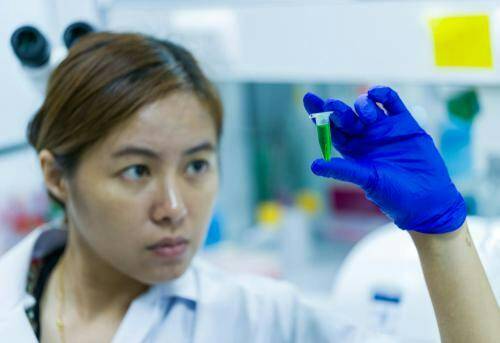Abstract: With the discovery of CRISPR-CaS9- CaS9 Technology, the Nobel Prize winner Jennifer Doudna stressed the responsibility of scientists to calibrate the accurate use of technology. This discovery has laid out immense possibilities in the field of Modern Biowarfare. Gene editing is said to play a major role in intelligentised warfare between countries such as the U.S., the People’s Republic of China, and North Korea. It can be used to produce genetically modified soldiers with enhanced physical and cognitive capabilities, sponsoring Neuro-linked Warfare. As the world is an abyss in quagmires of cyber warfare, trying to stay afloat by, the silently creeping dangers of gene editing remain unexplored and hidden until the day Pandora’s box splits apart.
Problem statement: How can transparency and informed consent be ensured when using gene editing technologies for military purposes, considering the complexities and uncertainties associated with genetic modifications?
So what?: By employing precision gene editing techniques such as CRISPR-Cas9, specific genes associated with traits like endurance, strength, and cognitive abilities can be modified to augment soldier capabilities while minimising off-target effects and unintended mutations. Ethical considerations must guide the process, ensuring transparency, informed consent, and adherence to established regulations to uphold the well-being and autonomy of military personnel. Additionally, ongoing research and interdisciplinary collaboration are essential to continually evaluate the efficacy, safety, and ethical implications of gene editing technologies in the context of military enhancement.

What is “Gene Editing”?
CRISPR (Clustered Regularly Interspaced Short Palindromic Repeats) technology is a powerful and versatile tool that allows scientists to edit genes with unprecedented precision. It works by utilising RNA molecules to target specific DNA sequences and then using the Cas9 enzyme to cut the DNA at the desired location. This cut triggers the cell’s natural repair mechanisms, leading to the introduction of desired genetic modifications. A genome is a complete set of DNAs or RNAs (in the case of viruses), which include the 2 per cent (2%) functional coding and the rest of the non-coding part of the genome.
CRISPR technology is a powerful and versatile tool that allows scientists to edit genes with unprecedented precision.
In recent years, there has been growing interest in the potential application of CRISPR technology in military contexts, including the genetic enhancement of soldiers. According to the South China Morning Post, a Chinese team behind an extreme animal gene experiment said it may lead to genetically modified soldiers who survive nuclear fallout.[1] A modified human embryonic stem cell has shown supernatural resistance against radiation, according to a paper by the Academy of Military Sciences team in Beijing. CRISPR technology is a powerful and versatile tool that allows scientists to edit genes with unprecedented precision.
The potential applications of CRISPR technology in military settings are diverse and have sparked considerable debate. One possible application is the enhancement of soldiers’ physical and cognitive abilities. For example, genes associated with strength, endurance, and cognitive function could be modified to create soldiers with enhanced physical performance. Gene editing could be used to optimise muscle strength, endurance, and agility, enabling soldiers to perform strenuous tasks more efficiently and for longer durations. It can also be used to Improve cognitive abilities such as enhanced memory, focus, decision-making, and problem-solving skills, potentially providing soldiers with a cognitive edge in high-pressure situations. Gene editing can also increase resilience to environmental stressors such as extreme temperatures, radiation, and lack of oxygen, thereby improving soldiers’ ability to operate in challenging environments. For instance, soldiers guarding Siachen Muztagh during winters experiencing -50 degrees Celsius can be more tolerant and adaptable to cold temperatures.[2] According to a paper published on psychological effects experienced by soldiers at high altitude, it was mentioned as Siachen Syndrome. According to data from mountaineers and pilots, long exposures could impair psychomotor performance. Certain psychiatric symptoms, including sleep disturbances, fatigue, and aches, were found in scientists having prolonged stays during six months of photoperiod in Antarctica.
During war, accelerated wound healing and recovery and reduced susceptibility to infections can be promoted to enhance overall recovery from injuries sustained in combat or training. Gene editing might enhance sensory abilities such as vision, hearing, and proprioception (touch sensation), allowing soldiers to detect threats more effectively and navigate complex environments with greater awareness. Genetic modifications targeting stress response pathways could potentially reduce the risk of developing stress-related disorders such as PTSD, enhancing soldiers’ mental resilience and well-being. It could bolster soldiers’ immune systems, making them less susceptible to infectious diseases and potentially increasing their resilience to biological threats encountered in the field.
Gene editing might enhance sensory abilities such as vision, hearing, and proprioception, allowing soldiers to detect threats more effectively and navigate complex environments with greater awareness.
Genomics and bioinformatics can play a major role in aiding personnel selection. By sequencing the DNA of a person, receptors associated with traumatic brain injury can be identified, and hence, this can lower the vulnerability of military personnel. To increase soldiers’ physical performance, former NASA employee Josiah Zayner used a CRISPR myostatin inhibitor on himself to demonstrate the impact of CRISPR on muscle mass. This technology remains controversial, yet XR and tissue engineering have the same effect with lesser invasiveness. Genome editing can also be used to engineer microbes in the human gut to enhance the host’s metabolism positively. Essentially, the engineered microbes can be used to produce the effects of body armour and helmets on the human body. As overreaching as it may sound, genetically engineered microbes can produce silk that can be used for wound healing and even for temporary tissue regeneration, aiding wound treatment, burns and injury recovery.
Perils of Genetically Modified Bioweapons
The new generation of biological weapons is developed by modifying the genetic code of pathogenic microorganisms through gene editing technology, which can attack the enemy from the genetic level. In simple terms, gene editing technology is equivalent to a pair of gene “scissors”, which can “splice” gene fragments of one organism to another according to subjective wishes, thereby changing its physiological characteristics. CRISPR Cas9 technology has been working to delete the CCR5 gene to prevent HIV infection in embryos and make them resistant to certain diseases.[3] This way, genetic weapons modify genes to obtain new pathogenic microorganisms, thereby invalidating the opponent’s vaccine library.
CRISPR Cas9 technology has been working to delete the CCR5 gene to prevent HIV infection in embryos and make them resistant to certain diseases.
From the 1970s to the 1980s, the rapid development of molecular genetics made it possible to develop genetic weapons. Genetic weapons are based on the recombination of deoxyribonucleic acid, the carrier of genetic information. With the help of genetic engineering methods, gene separation and recombination can be achieved to form composite deoxyribonucleic acid. On this basis, gene transfer can be achieved with the help of microorganisms to make biological weapons that can change genetic material. Since genetic weapons are “cut” out of new viruses and bacteria, the genetic code is only known to the designer, and it is difficult for the opponent to decipher it in time and develop a new vaccine to fight it. Even if the vaccine library is updated, there is still a steady stream of new genetic weapons “ready to go.”
India’s dependency on China’s Active Pharmaceutical Ingredients (APIs) poses several risks and challenges to its pharmaceutical industry. India relies heavily on China to import APIs, essential components in drug manufacturing. Any disruption in the supply chain, such as trade disputes, geopolitical tensions, or unforeseen events like pandemics, can severely impact India’s pharmaceutical production capabilities, leading to shortages of essential medicines. While China is a major global supplier of APIs, concerns have been raised regarding the quality and safety standards of some Chinese pharmaceutical ingredients. India’s dependency on these imports increases the risk of compromised quality control, potentially leading to substandard or counterfeit drugs entering the market.[4]
Dependency on China for APIs exposes India’s pharmaceutical industry to price volatility and market fluctuations.[5] Any changes in international trade policies, currency exchange rates, or production costs in China can lead to sudden price hikes for APIs, affecting the profitability of Indian drug manufacturers and the affordability of medicines for consumers. Overreliance on imports for critical pharmaceutical ingredients undermines India’s goal of achieving self-sufficiency and promoting domestic manufacturing capacity.[6]
Dependence on China for APIs raises strategic concerns for India’s healthcare. In times of geopolitical tensions or emergencies, reliance on a foreign supplier for essential medical supplies could compromise India’s ability to meet the healthcare needs of its population. For example, by transplanting gene fragments with reproductive solid ability, the reproductive and diffusion power of deadly germs can be increased several times; by transplanting gene fragments with strong pathogenic ability, the mortality rate can be increased to about 100%. Genetic weapons are concealed for different military purposes, environments, and attack targets. Users can artificially design the incubation period of genetic weapons. In other words, people can make genetic weapons into a kind of “time bomb”, and the “countdown” can last up to ten years. This is the most important difference between genetic, traditional biological and chemical weapons.
By transplanting gene fragments with reproductive solid ability, the reproductive and diffusion power of deadly germs can be increased several times.
Privacy and Human Rights
The PRC is running a project known as BGI Nifty Genetic Data Collection, a Non-Invasive Foetal Trisomy prenatal screening test developed by BGI Genomics to detect common chromosomal abnormalities in fetuses.[7] The PRC’s biggest genomics firm, BGI began marketing the test abroad in 2013. Branded NIFTY, it is among the world’s top-selling non-invasive prenatal tests (NIPT).[8] These screen a sample of blood from any pregnant woman to detect abnormalities such as Down Syndrome in a developing foetus. So far, more than 8 million women globally have taken BGI’s prenatal tests.
NIFTY is sold in at least 52 countries, including China, the U.S., Australia, Canada and European countries such as Slovenia, Germany and Estonia. It is even noted that pregnant women’s genetic data is used to analyse traits in a population.
BGI began working with Chinese military hospitals to study the genomes of foetuses in 2010 and has published over a dozen joint studies with People’s Liberation Army (PLA) researchers to trial and improve its prenatal tests. The PLA General Hospital in Beijing and the Third Military Medical University in Chongqing ran clinical trials on the NIFTY test in 2011.[9] They worked with BGI researchers to expand the genetic abnormalities the test screens for. In one example, the PLA General Hospital worked with BGI on the first Chinese prenatal trial to screen for dwarfism, which BGI later brought to market. It is a forerunner to screen out single-gene diseases.
Fears and concerns have been raised regarding the PRC’s misuse of DNA data, which has come under worldwide scrutiny. In fact, Norway’s National Consumer Council had issued a warning to its citizens using the kits against the potential misuse. BGI claims it has never retained any personal data from the NIFTY test. Yet, one of its clauses states the information sharing between the government if it is directly relevant to national security. Since 2015, the Chinese government has restricted access to genetic data by foreign researchers, whereas in 2019, it officially corroborated as a regulation on national security.[10] Artificial Intelligence (AI) use in gene editing also creates a frenzy among scientists. Eric Schmidt highlighted this concern in the U.S. Expert Panel of the National Security Commission. According to Progress Education Trust (PET), NIFTY stores genetic data of the mother and foetuses for a minimum of 5 years, after which the woman can ask for deletion. NIFTY samples include metrics such as height, weight, age, sex, race and medical history. Inferences are being drawn reflecting on the investigating link between genetics and population traits to single out Tibetan and Uighur Muslims. According to Anna Puglisi, a former U.S. Counterintelligence officer, “The combination of genomic data of unborn children with the medical data and history is extremely powerful.”[11]
The biosecurity issues stand out exclusively since these tests provide information about the nationality, medical history of the mother and sex of the foetus. The consent form filled out by pregnant mothers does not mention that their data shall end up in BGI headquarters based in Shenzhen, PRC. The collected information samples are generally stored in the PRC National Gene Bank, with geospatial positioning tracking of the mothers available through huge screens in real-time. This technology can be used to detect chromosomal anomalies in mothers, cancer, autoimmune disorders, drug history, and blood transfusions. This data can be extrapolated to exploit vulnerabilities in a suspect population and can be used to target a genetic attack. This project is spearheaded by Liang, whose work is patronised by ‘Military Medicine Innovation Project’.[12] Together, stem cells and gene therapy are targeted to combat deafness caused by weapon training in soldiers. The studies also explore the event of brain injury and brain fag at higher altitudes, signalling towards the Han Chinese soldiers who suffered, especially after the Galwan Valley clash. While CRISPR technology holds immense promise for various applications, including potential medical treatments, using such technologies in military contexts raises additional ethical, legal, and societal concerns.
The biosecurity issues stand out exclusively since these tests provide information about the nationality, medical history of the mother and sex of the foetus.
Ethical Considerations
One notable quote on ethics in gene editing comes from Dr. Jennifer Doudna, one of the pioneers of CRISPR technology:[13]
“Ethical considerations are critical in guiding the use of gene-editing tools, such as CRISPR-Cas9, to treat human disease or alter the human genome. We must address the ethical implications of such technologies head-on, engaging in robust public debate to ensure that our scientific discoveries are used for the betterment of humanity.”
– Dr. Jennifer Doudna –
The ethical considerations surrounding gene editing technology, particularly using CRISPR in soldiers, are complex and multifaceted.[14] Considering potential risks and uncertainties associated with the procedure, such as off-target mutations or unintended consequences, should be done. Ensuring the safety of soldiers is paramount. Any gene editing intervention must undergo rigorous testing to minimise individual health and well-being risks. Before providing consent, soldiers must fully understand the potential risks and benefits of gene editing. It is crucial to address equity issues to ensure fair access to gene editing technologies among soldiers, regardless of rank, nationality, or socioeconomic status. Gene editing raises concerns about fairness and the pursuit of military advantage. Policies must ensure that enhancements do not exacerbate existing inequalities or create new forms of discrimination.[15] Adequate regulation and oversight are essential to mitigate risks and ensure the responsible use of gene editing technologies in the military. Regulatory frameworks should prioritise safety, efficacy, and ethical considerations. Gene editing in soldiers may raise concerns about compliance with international laws and ethical standards. It is essential to consider the broader implications within the context of human rights, warfare, and global governance.
Dr. Paridhi Billore is a researcher, qualified medical practitioner, and researcher associated with Ramaiah University, Centre for National Security Studies Bengaluru. She has worked in multiple security think tanks, such as the Centre for National Security Studies, the United Service Institution of India, and the Centre for Land Warfare Studies. She has written about tradecraft, intelligence reforms, terrorism and psychological warfare. She takes a keen interest in neuro-linked warfare and gene editing as the future of modern warfare. The views contained in this article are the author’s alone and do not represent the views of Ramaiah University – CNSS.
[1] P. Mali, L. Yang, K. M., Esvelt, J. Aach, M. Guell, J. E. DiCarlo, and G. M. Church, “RNA-guided human genome engineering via Cas9. Science,” 339(6121), 823-826, DOI: 10.1126/science.1232033.
[2] J. Rong, P. Qiu, S. Liu, S. Wu, and Y. Liu, “Gene editing for cold resistance: applications and challenges,” Frontiers in Plant Science, 8, 1643, DOI: 10.3389/fpls.2017.01643.
[3] X. Kang, W. He, Y. Huang, Q. Yu, Y. Chen, X. Gao, and Z. Zhou, “Introducing precise genetic modifications into human 3PN embryos, CRISPR/Cas-mediated genome editing,” Journal of Assisted Reproduction and Genetics, 36(11), 2201-2208, DOI: 10.1007/s10815-019-01555-0.
[4] A. Chandra, A. Kumar, and P. Singh, “Pharmaceutical trade between India and China: A focus on trade balance, value chain and health security,” Journal of King Saud University – Science, 29(2), 163-175, DOI: 10.1016/j.jksus.2015.08.002.
[5] A. Sharma, “How China dominates India’s pharmaceutical sector,” The Diplomat.
[6] S. P. Singh, “India’s overdependence on China for Active Pharmaceutical Ingredients: A wake-up call,” Observer Research Foundation.
[7] J. R. Vermeesch, T. Voet, and K. Devriendt, “Prenatal and pre-implantation genetic diagnosis,” Nature Reviews Genetics, 17(9), 643-656, DOI: 10.1038/nrg.2016.89.
[8] Reuters, “Chinese gene firm BGI inks deal to buy U.S. life sciences company Gene by Gene,” Reuters, January 10, 2022.
[9] S. Hu, Y. Zhang, and L. Zhang, “Military Medical Research in China: Current Status and Future Prospects,” Military Medicine, 182(9-10), e1865-e1870, DOI: 10.7205/milmed-d-17-00060.
[10] L. Cong, F. A. Ran, D. Cox, S. Lin, R. Barretto, N. Habib, and F. Zhang, “Multiplex genome engineering using CRISPR/Cas systems. Science,” 339(6121), 819-823, DOI: 10.1126/science.1231143.
[11] Ministry of Science and Technology (PRC), “十三五”科技军民融合发展专项规划” [13th Five-Year Special Plan for S&T Military-Civil Fusion Development], 2017.
[12] W. Zhang, Z. Liu, T. Jiang, B. Wang, “Military Medicine in China: Old Lessons, New Challenges,” Military Medicine, 183(1-2), e148-e154, DOI: 10.1093/milmed/usx108.
[13] J. A. Doudna, E. Charpentier, “The new frontier of genome engineering with CRISPR-Cas9,” Science, 346(6213), 1258096, DOI: 10.1126/science.1258096.
[14] K. M. Esvelt, N. J. Gemmell, “Conservation demands safe gene drive,” PLOS Biology, 15(11), e2003850, DOI: 10.1371/journal.pbio.2003850.
[15] National Academy of Sciences and National Academy of Medicine, “Human genome editing: Science, ethics, and governance,” Washington, DC: National Academies Press, ISBN: 978-0-309-45288-5 .





